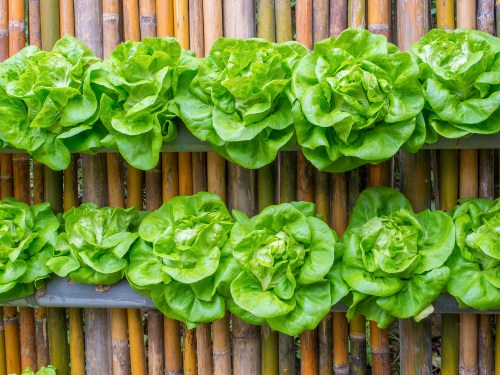
Vertical garden made from recycled grocery store pallets
The future of gardening is looking up! Vertical gardens are becoming a growing trend as savvy gardeners look to maximize small spaces. And modern tools and techniques are making these structures easier than ever to install and maintain. These days, many of my clients are adding green walls to their homes and reaping their benefits all year long.
What is a vertical garden?
At its most basic level, a vertical garden is a garden attached to either an exterior or interior wall. It can be composed of plants rooted in soil and suspended in containers from a grid.

Vertical garden made from potted plants
Or, it can be self-sustaining and soil-less. In the latter case, plants receive water and nutrients from within a modular structure. The structure acts as the ‘soil’ in which the plants grow.

Vertical garden with hydroponic vegetables
Vertical gardens that make use of hydroponic technologies are frequently referred to as green or living walls. They can include almost any plant type. Edibles, annuals, perennials, shrubs or even small trees are all possibilities, depending on prevailing climatic conditions.
The key to this form of gardening is to ensure water and nutrients flow evenly at regularly timed intervals over the plants. Not only will this keep roots properly fed, but it will also provide the ideal environment in which plants can thrive.
GREEN WALLS

Green wall
Nowadays, there are all sorts of DIY kits and ready-made living wall systems available for building green walls. There are also many companies that specialize in installing them. The standard components of a green wall include: 1) a frame; 2) waterproof backing or panels and water-absorbing fabric in which to nest the plants: and 3) an automatic irrigation system. A green wall is traditionally attached to a wall, but it can also be freestanding.
In vertical gardens, lightweight, porous fabrics take the place of soil. The fabric not only provides structural support for the plants but also furnishes the medium in which their roots grow. Plants are inserted through horizontal slits in the outer layer of the fabric or placed in fabric pockets.
Irrigation systems, regulated by timers, are the life source of this type of vertical garden. Mounted either on top of the structure or channeled throughout modular panels, they provide vital water and nutrients to the plants on the wall. A fertilizer injector valve, attached directly into the system, provides constant feeding to the soil-less plants. And a gutter placed at the bottom of the wall catches grey water that can be recycled.
One Central Park, Sydney, Australia
The largest vertical garden in the world is attached to the exterior walls of One Central Park, a pair of residential towers located in Sydney, Australia. It was designed by Patrick Blanc, a French botanist, considered the inventor of the vertical garden idea (mur végétal.)
Winner of the 2014 Council on Tall Building and Urban Habitat (CTBUH) prize for Best Tall Building Worldwide, the luxury apartments are the canvas for a stunning collection of living green walls that wrap the east and north facades of both towers. All in all, they include 38,000 indigenous and exotic plants.
Blanc has been designing and installing vertical gardens for over 30 years. His works are well known around the world. In Paris in particular, his large installation at the Quai Branly Museum provides an intriguing landmark.
Longwood Gardens’ Living Wall
Longwood Gardens, located in Kennett Square, Pennsylvania, recently won an award for its massive, 4,072 square foot green wall. Located in the gardens’ East Conservatory, the living wall is composed of more than 47,000 ferns, ivy, moss and other plants. Embedded into 3,590 modular panels, the plants are grouped according to their particular light preferences.
The wall is kept alive by computer sensors that regulate the temperature and control the flow of water and nutrients to each species. According to the garden’s caretakers, the green wall produces as much oxygen as ninety 14-foot trees.
SOIL-BASED VERTICAL GARDENS

Soil-based vertical garden
There are also many options for installing plants vertically without relying on hydroponics. And these kinds of gardens, composed of stacked, soil-based plants in containers, can be designed to fit almost any style and need. However, just as in traditional gardens, it’s important to choose the right plants for the space. That means taking into consideration how much sunlight the wall will receive as well as exposure to wind, humidity, cold and other environmental conditions.
One popular trend in vertical gardening is to arrange plants in pots, or other types of uniformly-shaped containers (new or recycled) and suspend them from grids.

Vertical garden of potted flowers
Another is to mix ornamental with edible plants. This is also an excellent way to grow food without chewing up a lot of space.

Vertical garden of hydroponic lettuce
Vertical gardening also provides opportunities for combining different species of plants to form interesting and colorful artworks. For instance, in addition to being functional, this vertical garden of potted herbs forms a colorful pattern.

Vertical herb garden
And this abstract-style wall is a vibrant quilt of bright-colored potted annuals.

Vertical garden of potted annuals
While this garden of same-species plants, set against a contrasting color, goes for a single-color, dramatic effect.

Vertical garden composed of trees in pots
For some other great ideas on how to start a DIY vertical garden, click here for morningchores.com very informative post.
Living works of art
Whether, hydroponic or soil-based, mounted on massive exterior structures or small interior frames, these beautiful works of living art are more than gardens. They improve air quality, cut noise pollution and contribute to our overall wellbeing. They also provide a tantalizing window into the possible future of gardening and agriculture overall.






Pingback: World's Largest Vertical Farm to Open in New Jersey Steel Mill - Here By Design